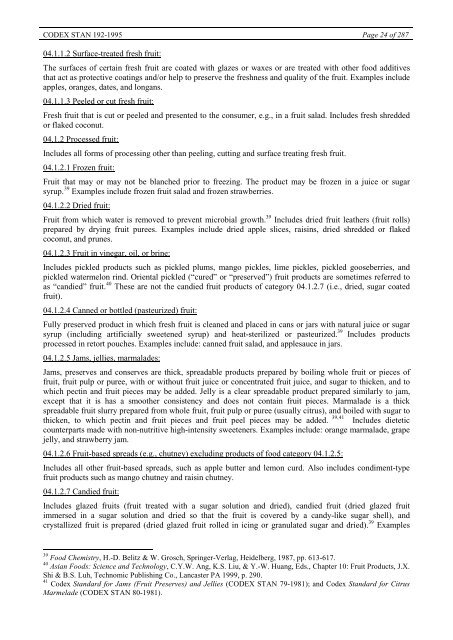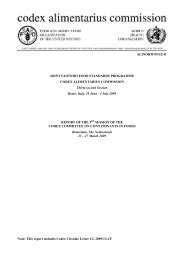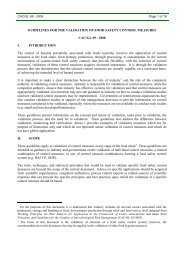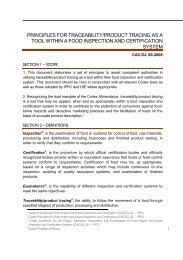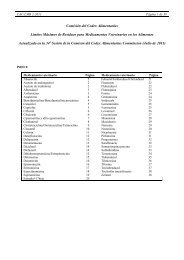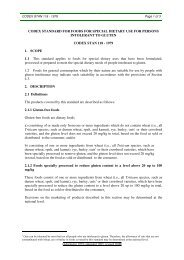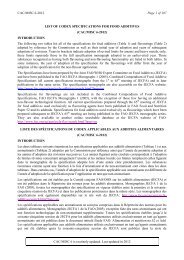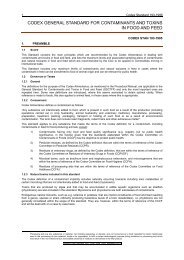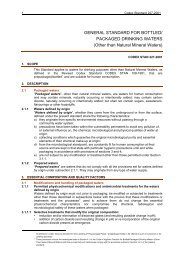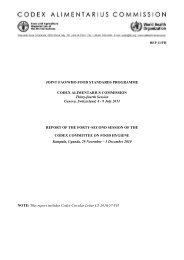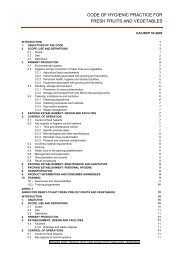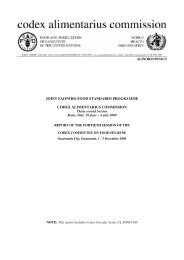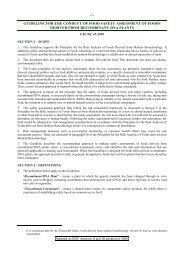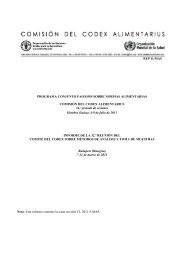General Standard for Food Additives - CODEX Alimentarius
General Standard for Food Additives - CODEX Alimentarius
General Standard for Food Additives - CODEX Alimentarius
You also want an ePaper? Increase the reach of your titles
YUMPU automatically turns print PDFs into web optimized ePapers that Google loves.
<strong>CODEX</strong> STAN 192-1995 Page 24 of 287<br />
04.1.1.2 Surface-treated fresh fruit:<br />
The surfaces of certain fresh fruit are coated with glazes or waxes or are treated with other food additives<br />
that act as protective coatings and/or help to preserve the freshness and quality of the fruit. Examples include<br />
apples, oranges, dates, and longans.<br />
04.1.1.3 Peeled or cut fresh fruit:<br />
Fresh fruit that is cut or peeled and presented to the consumer, e.g., in a fruit salad. Includes fresh shredded<br />
or flaked coconut.<br />
04.1.2 Processed fruit:<br />
Includes all <strong>for</strong>ms of processing other than peeling, cutting and surface treating fresh fruit.<br />
04.1.2.1 Frozen fruit:<br />
Fruit that may or may not be blanched prior to freezing. The product may be frozen in a juice or sugar<br />
syrup.<br />
39 Examples include frozen fruit salad and frozen strawberries.<br />
04.1.2.2 Dried fruit:<br />
39<br />
Fruit from which water is removed to prevent microbial growth. Includes dried fruit leathers (fruit rolls)<br />
prepared by drying fruit purees. Examples include dried apple slices, raisins, dried shredded or flaked<br />
coconut, and prunes.<br />
04.1.2.3 Fruit in vinegar, oil, or brine:<br />
Includes pickled products such as pickled plums, mango pickles, lime pickles, pickled gooseberries, and<br />
pickled watermelon rind. Oriental pickled (“cured” or “preserved”) fruit products are sometimes referred to<br />
40<br />
as “candied” fruit. These are not the candied fruit products of category 04.1.2.7 (i.e., dried, sugar coated<br />
fruit).<br />
04.1.2.4 Canned or bottled (pasteurized) fruit:<br />
Fully preserved product in which fresh fruit is cleaned and placed in cans or jars with natural juice or sugar<br />
39<br />
syrup (including artificially sweetened syrup) and heat-sterilized or pasteurized. Includes products<br />
processed in retort pouches. Examples include: canned fruit salad, and applesauce in jars.<br />
04.1.2.5 Jams, jellies, marmalades:<br />
Jams, preserves and conserves are thick, spreadable products prepared by boiling whole fruit or pieces of<br />
fruit, fruit pulp or puree, with or without fruit juice or concentrated fruit juice, and sugar to thicken, and to<br />
which pectin and fruit pieces may be added. Jelly is a clear spreadable product prepared similarly to jam,<br />
except that it is has a smoother consistency and does not contain fruit pieces. Marmalade is a thick<br />
spreadable fruit slurry prepared from whole fruit, fruit pulp or puree (usually citrus), and boiled with sugar to<br />
thicken, to which pectin and fruit pieces and fruit peel pieces may be added.<br />
39,41 Includes dietetic<br />
counterparts made with non-nutritive high-intensity sweeteners. Examples include: orange marmalade, grape<br />
jelly, and strawberry jam.<br />
04.1.2.6 Fruit-based spreads (e.g., chutney) excluding products of food category 04.1.2.5:<br />
Includes all other fruit-based spreads, such as apple butter and lemon curd. Also includes condiment-type<br />
fruit products such as mango chutney and raisin chutney.<br />
04.1.2.7 Candied fruit:<br />
Includes glazed fruits (fruit treated with a sugar solution and dried), candied fruit (dried glazed fruit<br />
immersed in a sugar solution and dried so that the fruit is covered by a candy-like sugar shell), and<br />
39<br />
crystallized fruit is prepared (dried glazed fruit rolled in icing or granulated sugar and dried). Examples<br />
39<br />
<strong>Food</strong> Chemistry, H.-D. Belitz & W. Grosch, Springer-Verlag, Heidelberg, 1987, pp. 613-617.<br />
40<br />
Asian <strong>Food</strong>s: Science and Technology, C.Y.W. Ang, K.S. Liu, & Y.-W. Huang, Eds., Chapter 10: Fruit Products, J.X.<br />
Shi & B.S. Luh, Technomic Publishing Co., Lancaster PA 1999, p. 290.<br />
41<br />
Codex <strong>Standard</strong> <strong>for</strong> Jams (Fruit Preserves) and Jellies (<strong>CODEX</strong> STAN 79-1981); and Codex <strong>Standard</strong> <strong>for</strong> Citrus<br />
Marmelade (<strong>CODEX</strong> STAN 80-1981).


